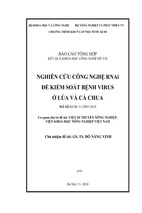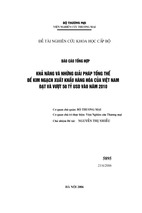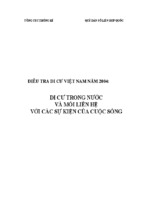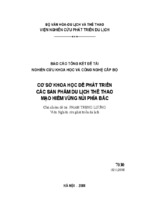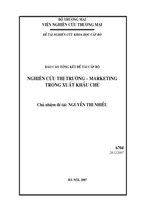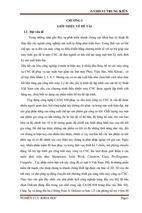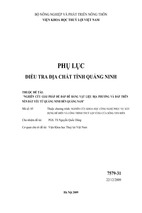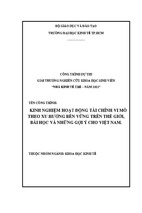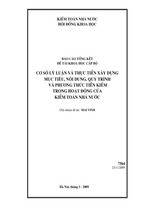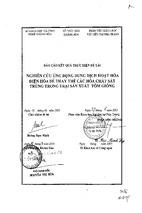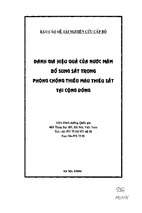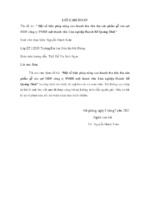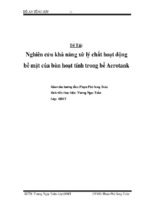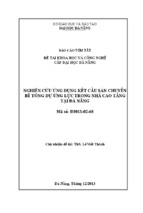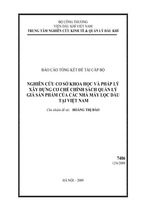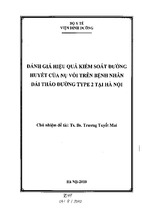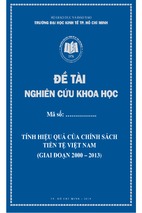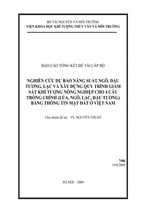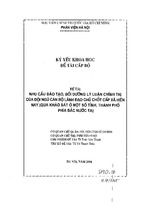See discussions, stats, and author profiles for this publication at: https://www.researchgate.net/publication/314552876
Caregiving burden among relatives of cancer patients in Vietnamese national
oncology hospital
Article · January 2015
CITATIONS
READS
0
431
2 authors, including:
Ly Thuy Nguyen
Queensland University of Technology
7 PUBLICATIONS 12 CITATIONS
SEE PROFILE
Some of the authors of this publication are also working on these related projects:
A Psychoeducational Intervention for Symptom Cluster Management among Cancer Patients View project
All content following this page was uploaded by Ly Thuy Nguyen on 24 October 2017.
The user has requested enhancement of the downloaded file.
VIETNAM JOURNAL OF MEDICINE AND PHARAMCY
CAREGIVING BURDEN AMONG RELATIVES OF CANCER PATIENTS IN
VIETNAMESE NATIONAL ONCOLOGY HOSPITAL
Ly Nguyen Thuy, Trang Ta Ngoc Dan
Department of Nursing and Midwifery, Hanoi Medical University, Hanoi, Vietnam
Correspondence
Ly Nguyen Thuy
Department of Nursing and Midwifery, Hanoi Medical University, Hanoi, Vietnam,
No1 Ton That Tung Street, Hanoi, Vietnam
Email:
[email protected]
ABSTRACT
Family involvement has significant influences on decision-making processes, the
receiving and sharing of information, and the provision of physical and emotional
support for patients. This role commonly causes a substantial burden and caregivers
often experience negative psychological, behavioral, and physiological effects on
their daily lives and well-being. Caring for people with cancer can have significant
impacts on caregivers as well as caregivers’ outcomes, which in turn can have
negative impacts on the people being cared for. However, their burden of care does
not attract appropriate attention in the Vietnamese health care system.
Objectives
To describe the caregiving burden among family caregivers of cancer patients and to
explore the factors associated with the levels of caregiving burden among relatives
of patients with cancer.
Methods
One-hundred and seven family caregivers of oncology patients in a Vietnamese
National Oncology Hospital participated in the cross-sectional study by completing
available questionnaires including the Zarit Burden Interview (ZBI), Activities of Daily
Living (ADL) and Instrumental Activities of Daily Living (IADL).
Results
The average ZBI score was 48.9 ± 13.7, in which 72% of participants reported high
caregiving burden levels and 28% of them experienced mild and moderate levels.
Higher burden was reported in older caregivers (r=0.21, p=0.03), female caregivers
(t=-3.51, p<0.001), caregivers who had no other support in caring (t=-2.78, p<0.01),
and caregivers spent longer hours caring at hospital (r=0.40, p<0.01), as well as at
VJMP 8(2)-2015
1
VIETNAM JOURNAL OF MEDICINE AND PHARAMCY
home (r=0.46, p<0.01). Patient’s spouse reported higher burden than patient’s
offspring (F=4.33, p<0.01). Regarding patients’ background factors, male patients
(t=2.29, p<0.02) and patients who were breadwinners (t=3.13, p=0.02), diagnosed
with cancer for more than 2 months (F=4.26, p=0.01) and undergone radiotherapy
(t=2.02, p=0.05) or surgery therapy (t=2.17, p=0.03) experienced greater burden
than the others. Importantly, the study found that the less independent patients were,
the higher burden of care that caregivers would perceive (p<0.05).
Conclusions
The study results provided evidence concerning the high caregiving burden levels
among relatives of cancer patients within Vietnamese cultural contexts. Caregivers’
and patients’ background factors were significantly associated with different levels of
burden that caregivers perceived. This study provided an important foundation for
future development of evidence-based interventions to support caregivers of cancer
patients in Vietnam.
Keywords
Caregiving burden, cancer caregiver, Vietnam
VJMP 8(2)-2015
2
VIETNAM JOURNAL OF MEDICINE AND PHARAMCY
BACKGROUND
Cancer is a major public health problem in the world. This disease is one of the
leading causes of death worldwide, accounting for 8.2 million deaths globally in 2008
[1]. In Vietnam, cancer has been considered as an emerging major health problem
since the 1990s [2]. It is estimated that about 150.000 people are diagnosed with
cancer each year in Vietnam and only 5% of them receive prompt treatments [3].
Cancer has been reported as an important contributor to the burden of death in
Vietnam. The annual mortality due to cancer is 75.000, equal to 14% of the total
deaths of the country [3]. In Vietnamese traditional culture, relatives of patients,
especially family members, are immediate people who care for daily routines and
personal activities of the patients. The care for cancer patients has complex
requirements in different stages of the disease. Therefore, the family plays an
important role to provide the high level of care needed for both physical and
psychological care of cancer patients. However, various kinds of caring tasks put a
heavy burden on family caregivers’ lives.
This leads to the concern that the levels of burden on caregivers of cancer patients
are greater than those of other diseases and thought to be similar to the caring
demands for patients with dementia [4]. Evidence has shown that caring burden
related to numerous factors may negatively influence caregivers in psychological,
physical and social aspects of their lives [4].
To date, a considerable amount of literature has been published about caregiving
burden among caregivers of cancer patients worldwide. However, much of the
research up to now has been carried out to describe the nature of burden of care for
professional caregivers. Little is known about the caregiving burden of family
relatives of oncology patients. Moreover, care burden is and under-researched topic
within the Vietnamese context and thus, questions has been raised about the level of
burden as well as the associated factors. The study was conducted with two main
objectives, to:
1. Describe the levels of caregiving burden among cancer patients’ relatives who
provide care for oncology patients in a Vietnamese National Oncology hospital.
2. Explore the factors associated with the level of caregiving burden among
relatives of cancer patients in a Vietnamese National Oncology hospital.
VJMP 8(2)-2015
3
VIETNAM JOURNAL OF MEDICINE AND PHARAMCY
METHODS
Study population
Inclusion criteria: (a) be family members of cancer patients in the Medical
Department of Oncology, Vietnamese National Oncology Hospital from September
2014 to October 2014, (b) provide assistance and offer care for patients without
payments, (c) voluntarily participate in the study.
Exclusion criteria: difficulties in communication.
Methods
Study design: a descriptive cross-sectional study applied the technique of face-toface interview by questionnaire.
Samples and sampling
A convenience sampling method was used to recruit participants who met the
inclusion criteria. The sample size was calculated according to the formula provided
by Lwanga and Lemeshow [5]:
In which n: sample size; 1- α/2: confidence level with α= 0.05, Z= 1.96; P: assuming
percentage of relatives with moderate or higher burden of caregiving at 0.5; d:
absolute precision required; d=0.1 and n=97. An additional 10 participants (10%)
were recruited for a total sample size of 107 people.
Research Instruments
Questionnaires included 3 sections. Part 1: to determine the background factors of
caregivers and patients: demographic characteristics (20 items). Part 2: to determine
the level of caregiving burden: Zarit Burden Interview- ZBI (22 items). The items are
worded subjectively, focusing on the affective response of the caregiver. Each
question is scored on a 5-point scale ranging from - never to nearly always present.
Total scores range from 0 (low burden) to 88 (high burden). If ZBI total score of <21:
“little or no burden”; 21 to 40: “mild to moderate burden”; 41 to 60: “moderate to
severe burden” and a score >61: “severe burden” [6]. Part 3: to determine the level
of patient’s independence: Activities of Daily Living-ADL (6 items) and Instrumental
Activities of Daily Living (IADL). The higher ADL and IADL score indicated the higher
level of patient’s independence. These tools in Vietnamese versions were validated
VJMP 8(2)-2015
4
VIETNAM JOURNAL OF MEDICINE AND PHARAMCY
and employed in the previous study conducted among a Vietnamese population [7].
Therefore, the instruments were considered appropriate to use in this study in the
Vietnamese context. The internal consistency of these instruments were measured
in this study with Cronbach’s Alpha for ZBI, ADL, IADL were 0.845; 0.8 and 0.803,
respectively.
Data analysis
Firstly, frequencies and percentages were calculated for each of the variables. Then
bivariate analysis (students T test for 2 groups or ANOVA, analysis of variance for
more than 2 groups of independent variables, and Pearson’s correlation for
continuous independent variables) was used to explore the associations between
background characteristics and total score of ZBI. The level of significance for all
analyses was set at less than 0.05.
Ethical considerations
This study had approval from the research committee of Hanoi Medical University.
Before inclusion, the purposes of the research and benefits of the participants were
presented in a cover letter attached to the questionnaire. Written informed consent
was gained from all participants who took part in the study. Participants were
informed that they could withdraw from this research without comment or penalty.
RESULTS
Caregivers
VJMP 8(2)-2015
5
VIETNAM JOURNAL OF MEDICINE AND PHARAMCY
Table 1. Background factors of caregivers (categorical variables)
Variables (n=107)
Male
Married
Education levels
High school or less
College/ Immediate level
University or higher
Occupation
Farmer/ worker
Government staff
Business
Other
Living with patient
Having other people support in caring
Types of patient-caregiver relationship
Spouse
Children
Parent
Other
Frequencies
60
87
%
56.1
81.3
73
16
18
68.2
15.0
16.8
60
15
12
20
78
55
56.1
14.0
11.2
18.7
72.9
51.4
54
37
4
12
50.5
34.6
3.7
11.2
Table 1 shows the background factors (categorical variables) of caregivers. Among
107 respondents, more than half of them were male (56.1%) and patient’s spouse
(50.5%).
Table 2. Background factors of caregivers (continuous variables)
Variables (n=107)
Caring time; (hours/week)
In the hospital
At home
Family’s average income
(million Vietnam dong)
Number of financial
dependent people
Average age (years)
Mean (SD)
Min-Max
124.1(63.0)
51.8 (66.5)
1-168
0-168
7.8 (11.8)
0.3-70
1.4 (1.2)
0-5
42.5 (13.6)
20-71
Table 2 demonstrates the background factors (continuous variables) of caregivers.
The average of time caring for patients at hospital was 124.1 (63.0) and at home was
51.8 (66.5
VJMP 8(2)-2015
6
VIETNAM JOURNAL OF MEDICINE AND PHARAMCY
Table 3. Background factors of patients
Variables
%
Frequencies
Male
The treatment therapies has been used
Chemotherapy
Radiotherapy
Surgical
Types of cancer
Reproductive system
Gastrointestinal
Respiratory system
Other
Be the main income of caregiver’s family
Disease duration (months)
< 2 months
2-6 months
6months-5 years (60 months)
> 5 years
Variables
Average age(years)
Patient’s independent level
ADL (possible score: 0-6)
IADL (possible score: 0-8)
55
51.4
95
53
50
88.8
49.5
46.7
40
37
21
9
44
37.4
34.4
19.6
8.5
41.1
22
41
34
10
Mean (SD)
52.0 (10.6)
20.6
38.3
31.8
9.3
Min-max
24-69
5.2 (1.6)
5.15 (1.6)
0-6
0-8
The background factors of patients are illustrated in Table 3. The number of male
patients made up the larger proportion (51.4%) and the average age of patients in
this study was 52.0 years old (SD=10.6). Of participants, 58.9% had been the main
income
contributors. Percentage
of
patients
who
have
been
treated
by
chemotherapy, ratio therapy and surgery were 88.8%, 49.5% and 46.7%,
respectively.
Burden category
Little or no burden
Mild to moderate burden
0%
17%
Average total ZBI score: 48.9±13.7
Possible score: 0-88
28%
Min-max: 22-85
55%
Figure 1. Caregiving burden’ level among caregivers
VJMP 8(2)-2015
7
VIETNAM JOURNAL OF MEDICINE AND PHARAMCY
Figure 1 demonstrates the score of Zarit Burden Interview (ZBI). The average score
of ZBI of caretakers was 48.9 (SD=13.7), ranging from 22 to 85. This score was
indicated as “moderate to severe” level of high level of burden. Specifically, none of
the participants reported little or no burden. The majority of caregivers experienced
high level burden including 55% for “moderate to severe burden” and 17% for
“severe burden”.
Table 4. Associations between total ZBI scores and categorical variables of
caregiver’s characteristics
Factors
Mean (SD)
Gender
Male
45.0 (12.0)
Female
53.9 (14.1)
Marital status
Singer
46.4 (11.0)
Married
49.4 (14.2)
Education
High school or less
49.6 (14.3)
College/ Immediate
50.7 (11.9)
University or higher
44.2 (12.1)
Occupation
Farmer or worker
51.7 (14.0)
Government staff
46.5 (11.9)
Business
42.6 (11.8)
Other
46.6 (13.6)
Co-resident
Yes
50.2 (13.5)
No
45.2 (13.6)
Other support
Yes
45.3 (10.1)
No
52.6 (15.9)
Types of patient-caregiver relationship
Spouse
53.1 (13.1)
Children
43.1 (9.3)
Parent
48.0 (23.9)
Other
47.5 (18.3)
95%CI
Lower
upper
t/F
p
42.0
49.9
48.2
58.3
t=-3.51
0.00**
41.3
46.5
51.3
52.7
t=-0.90
0.37
46.3
44.3
38.2
52.9
57.1
50.2
F=1.12
0.35
48.07
39.9
35.1
46.3
55.3
53.1
50.1
51.5
47.3
40.4
53.6
50.1
t=1.69
0.09
42.9
48.2
48.1
56.9
t=-2.78
0.01*
49.6
40.1
9.9
35.9
56.7
46.3
86.1
59.1
F=1.49
F=4.33
0.20
0.01*
Significant at * p<0.05, ** p< 0.01
Table 4 shows the relationships between ZBI scores and categorical variables of
caregivers’ characteristics. A significant higher caregiving burden were found in
female caregivers (53.9±14.1) rather than male caregivers (45.0±12.0); caregivers
providing care alone (52.6±15.9) rather than those who received other support
(45.3±10.1); and caregivers who were patient’s spouses (53.1±13.1) rather than
VJMP 8(2)-2015
8
VIETNAM JOURNAL OF MEDICINE AND PHARAMCY
patients’ children (43.1±9.3).
Table 5. Associations between total ZBI scores and continuous variables of
caregiver’s characteristics
Factors
Age
Caring time
In hospital
At home
Income
Number of financial dependent people
r
p
0.40
0.46
-0.17
0.15
0.00**
0.00**
0.07
0.12
Significant at * p<0.05, ** p< 0.01
Table 5 indicates the significant positive correlations between burden and caregiver’s
age (p=0.03) and caring time (p<0.001).
Table 6.Associations between ZBI scores and categorical variable of patients’
characteristics
Mean ±SD
Factor
Gender
Male
Female
Chemotherapy
Yes
No
Radio therapy
95%CI
Lower
Upper
51.9 (15.0)
46.0 (11.6)
42.0
49.8
48.2
49.8
49.2 (14.2)
45.8 (8.8)
46.2
40.7
Yes
51.5 (12.1)
No
Surgery
Yes
No
Main income
Yes
No
Types of cancer
Reproductive
Gastrointestinal
Respiratory system
Other
Disease duration
<2 months
2-6 months
6months-5 years
>5 years
t/F
p
t=2.29
0.02*
52.1
51.4
t=0.82
0.41
48.4
54.9
t=2.02
0.05*
46.2 (14.7)
42.4
50.4
45.9 (11.2)
51.5 (15.1)
42.7
47.5
48.9
55.4
t=-2.17
0.03*
53.9 (15.3)
45.3 (11.3)
49.6
42.7
58.7
48.3
t=3.13
0.02*
44.3 (11.1)
51.7 (15.7)
52.7 (13.2)
46.6(13.8)
40.7
46.4
46.7
41.0
47.8
56.9
58.7
52.0
F=2.2
0.09
41.6 (12.9)
53.2 (15.3)
49.7 (11.6)
44.3 (6.7)
35.8
48.4
45.7
39.5
47.3
58.0
53.8
49.1
F= 4.26
0.007**
Significant at * p<0.05, ** p< 0.01
VJMP 8(2)-2015
9
VIETNAM JOURNAL OF MEDICINE AND PHARAMCY
Table 6 illustrates the relationships between ZBI scores and categorical variables of
patients’ characteristics. Higher caregiving burden were found in: caregivers of
female patients (53.9±14.1) than male patients (45.0±12.0); caregivers of patients
who were main income contributors (45.3±10.1) rather than caregivers of patients
who were not (45.3±11.3); caregivers of patients undergoing radiotherapy, and of
patients undergoing surgery rather than relatives of patients without these
interventions; caregivers of patients having disease less than 2 months (41.6±12.9)
rather than those caring for patients diagnosed from 2 to 6 months (53.2±15.3).
Table 7.Associations between ZBI scores and Active Daily Living (ADL) and
Instrument Active Daily Living (IADL)
Variables
ADL
IADL
r
-0.23
-0.35
p
0.02*
0.00**
Significant at * p<0.05, ** p< 0.01
A significant negative correlation between ZBI score and patient’s independent level
is reported in Table 7.
DISCUSSION
Characteristics of participants
Caregivers: More than half of the caregivers were male (56.1%) with an average
age of 42.5 ±13.6 years-old. The main occupations of caregivers in our study were
farmers and employees; therefore, their relationships and social activities were
narrower than a study population with varied occupations of other research [8,9].
More than a half of caregivers (68.3%) had education at an ordinary level (high
school or less). The Majority of caregivers were patients’ spouses, thus, it is easy to
understand that almost all of the participants were living with the patient in the same
house. The average time that caregivers spent for caring in the hospital was 124.1
(SD=63) hours/ week, larger than the result of a study in the United States with 18.9
hours/ week [8]. Similarly, the average caring time in the family was 51.8 (SD=66.5)
hours/ week, higher than the result of a study in Vietnam in 2006 on the terminally ill,
which was 10 hours / week [10].
Patients:
The average age of patients was 52 years, with an average disease
duration of 19.6 months. The patients who had been diagnosed with cancer for 2-6
months made up the highest proportion. This study was conducted in the Medical
Department of Oncology, which may have resulted in a high percentage of patients
VJMP 8(2)-2015
10
VIETNAM JOURNAL OF MEDICINE AND PHARAMCY
(88.8%) treated by chemotherapy.
The level of caregiving burden
The average caregiving burden score among caregivers in this study is considered
higher compared with research on relatives of dementia patients in Brazil (31.4 ±
16.0) [11] and in Vietnam (29.30 ± 13.58) [12]. In Vietnam, the family plays an
integral role in the delivery of health care, in that family members provide for basic
physical needs of patients, including hygiene, nutrition and hydration. Therefore, it is
reasonable as none of participants in this study reported little or no burden. Almost
all of the caregivers experienced high levels of burden, including 55% for moderate
to severe burden and 17% for severe burden.
The associations between caregiving burden and caregiver’s characteristics
Our study illustrated that female care providers had higher levels of burden and
depression than male caregivers. This is supported by the findings of other studies
conducted in America in 1992 [13] and in Vietnam in 2014 [7]. Women are more
likely to experience major depression related to greater life pressures than men [14].
Moreover, in this study, the average age was 44.9, which is in the premenopausal
period for women. Therefore, female care providers become more susceptible to the
burden for caring. Unsurprisingly, this study indicated that the older caregivers were
the greater burden they reported. This may be due to the fact that older care
providers are more likely to be in a reduced physical state and have restricted social
and financial resources, compared to younger caregivers. These disadvantages
combined with the risks of chronic conditions will become a big challenge to caring.
The previous study showed that caregivers with chronic diseases reported a poorer
quality of life and experienced a higher burden of care than healthy caregivers [9].
Moreover, having other people supporting in caring indicated that caregivers might
experience less total burden. It is generally expected that caring time will be reduced
when more than one person is taking care of the patient. This may decrease the
pressure on caring responsibilities and obligations for the patient's relatives.
Importantly, caring tasks greatly influenced patient/spouse relationships, social roles
and time to care for themselves. The findings were supported by previous studies
worldwide [15,16] and in Vietnam [12], which reported that spouse caregivers
expressed higher degree of role strain than others. Spouses play an important role
as the primary caregivers [17] as they support the patients both emotionally and
VJMP 8(2)-2015
11
VIETNAM JOURNAL OF MEDICINE AND PHARAMCY
physically while filling all or most of the roles that the patients had previously played.
The main burden, therefore, falling on the spouse, is perceived as heavier.
Especially, the study showed that the burden of care and caring time were positively
correlated with each other. If they were spending too much time caring for others,
caregivers may not have had sufficient time to meet their own needs, leading to
decreased health status [18].
The associations between caregiving burden and patient’s characteristics
This study indicated that in the families in which the patient works as the main
source of income, caregivers could report higher levels of burden. As the illness will
reduce the working capacity of patients, along with increased health service
expenses, which can lead to a decrease of family income and financial imbalances,
this will have a profound impact on the economic status of the family, and also put
tremendous pressure on caregivers. Moreover, the study showed that caregivers of
patients with 2 to 6-month disease duration reported a higher burden than caregivers
of patients with less than 2 months disease duration. Evidence has shown that, at
the period from 2 to 6 months after diagnosis, patients experienced the side effects
of treatments, such as headache, nausea and dizziness [19]. Greater severity of the
patient's symptoms and behavioral disturbances result in a greater “burden” to
caregivers (usually rated by the caregivers) [20]. Importantly, in this study, there was
a positive correlation between patient's independence levels and caregiver's burden.
This result was similar to the previous results found in the study of Lowenstein in
2000 [21]. When patients are able to take part in the self-care activities, their caring
demands will be reduced. This means caring for these patients requires less time
than for more dependent patients, and thus minimizes caregiving burden among
patient’s relatives.
CONCLUSIONS
The study results indicated high levels of caregiving burden among relatives of
cancer patients. Therefore, there is a need to support these caregivers to reduce
their burden of care, which was significantly influenced by background factors of
caregivers (gender, age, spouses) and patients (main income, disease duration,
independent levels) as well as caring time and support required for individual cancer
patients.
VJMP 8(2)-2015
12
VIETNAM JOURNAL OF MEDICINE AND PHARAMCY
ACKNOWLEDGEMENTS
The authors would like to express our heartfelt thanks to all cancer patients’
caregivers who participated in this study
REFERENCES
1. Boyle P, Levin B. World cancer report 2008. IARC Press, International Agency
for Research on Cancer 2008.
2. Ngoan lT, Lua NT, Hang L. Cancer mortality pattern in Viet Nam. Asian Pacific
Journal of Cancer Prevention. APJCP 2006;8(4): 535-8.
3. Nguyen Hoang Long, Bales S, Pham Trong Thanh, et al. Improving quality of
medical services. the Joint Annual Health Review 2012.
4. Kim Y, Schulz R. Family caregivers' strains comparative analysis of cancer
caregiving with dementia, diabetes, and frail elderly caregiving. Journal of Aging
and Health 2008;20(5):483-503.
5. Lwanga SK, Lemeshow S. Sample size determination in health studies: a
practical manual. World Health Organization 1991.
6. Hébert R, Bravo G & Préville M. Reliability, validity and reference values of the
Zarit Burden Interview for assessing informal caregivers of community-dwelling
older persons with dementia. Canadian Journal on Aging/Revue Canadienne du
vieillissement2000;19 (4): 494-507.
7. Trung Truong Quang. The
quanlity of life and caregiving burden among
caregivers of people with dementia in Hanoi, Bac Ninh and Hai Phong, Vietnam.
Queensland University of Technology, Australia 2014.
8. Greenwald M. Caregiving in the US, 2009.Associates Washington Caregiving
NAf, AARP 2009.
9. Grunfeld E, Coyle D, Whelan T, Clinch J, Reyno L, Earle CC, et al. Family
caregiver burden: results of a longitudinal study of breast cancer patients and
their
principal
caregivers.
Canadian
Medical
Association
Journal
2004;170(12):1795-801.
10. Green K, Kinh L, Khue L. Palliative care in Vietnam: findings from a rapid
situation analysis in five provinces. Hanoi: Vietnam. Ministry of Health 2006.
11. Fialho PPA, Koenig AM, dos Santos EL, Guimarães HC, Beato RG, Carvalho
VJMP 8(2)-2015
13
VIETNAM JOURNAL OF MEDICINE AND PHARAMCY
VA, et al. Dementia Caregiver burden in a Brazilian sample. Dementia &
Neuropsychologia 2006; 132-5.
12. Ngoc NB. Quality of life of Alzheimer's disease patients, their caregiver and
effectiveness asessment of some non-pharmacological intervention. Journal of
Communication Disorders 2014.
13. Miller B, Cafasso L. Gender differences in caregiving: Fact or artifact?. The
Gerontologist 1992;32(4):498-507.
14. Rosch PJ. Why Do Women Suffer More From Depression And Stress? 2014.
15. Gilbar O. Gender as a predictor of burden and psychological distress of elderly
husbands and wives of cancer patients. Psycho‐Oncology 1999;8(4):287
16. Hoyert DL, Seltzer MM. Factors related to the well-being and life activities of
family caregivers. Family Relations 1992;74-81.
17. Cantor MH. Strain among caregivers: A study of experience in the United States.
The Gerontologist 1983.
18. Wang L, Chen W, Chang S, Wong O, Hong R, Wang R. Caregiving burden and
associated factors among caregivers of terminally ill gastrointestinal cancer
patients. Hu li za zhi The Journal of Nursing 2011;58(6):54-64.
19. Burstein HJ. Side effects of chemotherapy. Journal of Clinical Oncology
2000;18(3):693.
20. Perring C, Twigg J, Atkin K. Families caring for people diagnosed as mentally ill:
The literature re-examined. HM Stationery Office 1990.
21. Lowenstein A, Gilbar O. The perception of caregiving burden on the part of
elderly cancer patients, spouses and adult children. Families, Systems, & Health
2000;18(3):337.
VJMP 8(2)-2015
14
View publication stats


